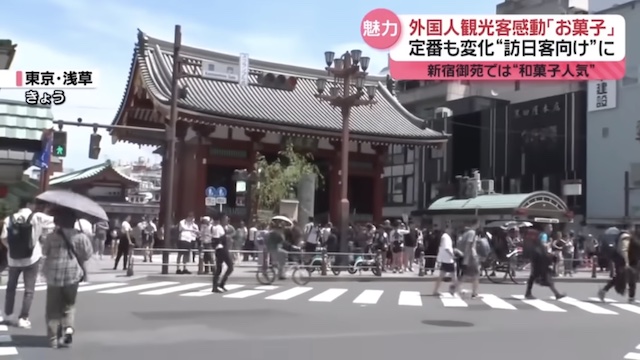TOKYO, May 23 (News On Japan) - In cities and tourist spots across Japan, foreign tourists can be seen devouring Japanese snacks. Now, many traditional products are evolving to cater to the inbound tourist market. We explored why foreign tourists are so enchanted by Japanese snacks.

In Ueno, Tokyo, foreign tourists were seen filling their baskets with Japanese snacks.
A tourist from France exclaimed, "Kaminari Okoshi, amazing!" and "Amanatto," adding, "All the snacks are delicious. I love them very much."
Many tourists were buying snacks in bulk as souvenirs for their home countries. A tourist from Israel said, "I absolutely want to try this! Squid crackers!" and "Do you eat the tail too?" purchasing anything that caught their interest.
The Israeli tourist continued, "I buy everything that looks delicious. The nori-shio flavored potato chips I found in Hida Takayama were the best. If I find something cool, I'll keep buying it."
Japanese snacks captivate foreigners. According to a survey conducted among residents of Taiwan and Hong Kong, snacks were the most desired items to buy in Japan, surpassing medicine and food (based on a reader survey from the information site 'Lachigo! Japan' for visitors from Taiwan and Hong Kong).
Manufacturers are also targeting foreign visitors. Meiji sells rich-flavored chocolate with Japanese-style packaging, and Kameda Seika's "Kaki no Tane" revamped its packaging for the first time in eight years, adding English text to highlight its popularity in Japan. The famous "Akafuku" from Ise City, Mie Prefecture, has even introduced Western-style variations, adding chocolate and strawberry flavors to its lineup.
Shinjuku Gyoen, an "urban oasis" that attracts over a million foreign visitors annually, houses a more than 300-year-old traditional Kyoto confectionery shop. American tourists here often order matcha and traditional sweets like manju. Over half of the customers are foreigners.
A tourist from Canada purchased manju filled with sesame anko, commenting, "Very good. It tastes like a healthy version of chocolate cookies. I've never tasted anything like this before." The dough used soy sauce, surprising the Canadian tourist who said, "Does this contain soy sauce? I couldn't tell at all! But it's really delicious."
Japanese snacks delight foreign tourists, but what about snacks from other countries? We asked tourists, "Tell us about the famous snacks from your country!"
A tourist from Turkey, currently on an "Asia tour" including Japan and Korea, shared, "In my hometown of Turkey, we have a very sweet dessert called baklava. It contains pistachios and sugar." Baklava is a layered pastry filled with nuts and pistachios, baked and soaked in sweet syrup. It's enjoyed not only in Turkey but also in neighboring countries. The Turkish tourist added, "We prepare and eat it on very special occasions, such as religious festivals."
A tourist from Spain talked about a treat called "Roscón de Reyes," eaten on January 6th, which is the Spanish Christmas holiday. This giant doughnut-like pastry, actually a sweet bread, contains hidden surprises like a fava bean and a king figurine. The tourist explained, "If you find the fava bean, you have to buy the next year's pastry as a penalty." This "Russian roulette" style treat brings joy and excitement to the festivities.
The love for snacks is universal, and Japanese snacks are becoming increasingly beloved worldwide.
Source: 日テレNEWS















